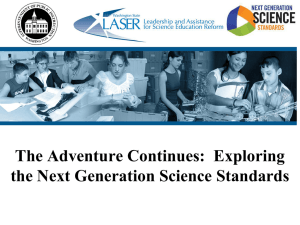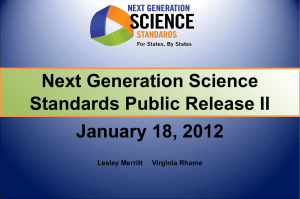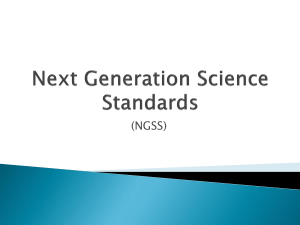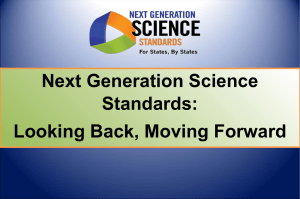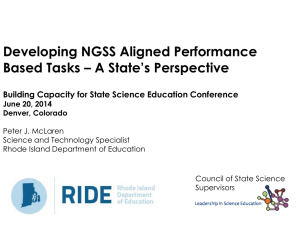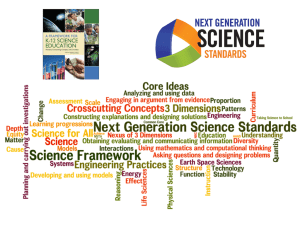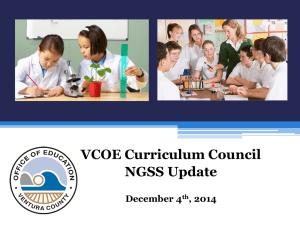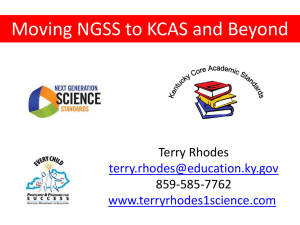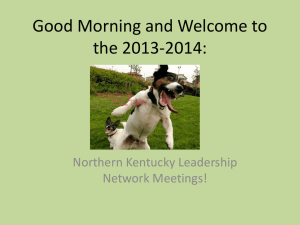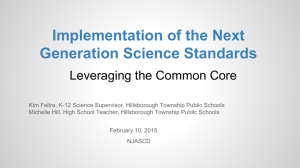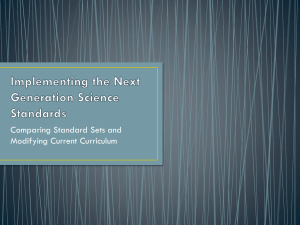NGSS 3-26
advertisement
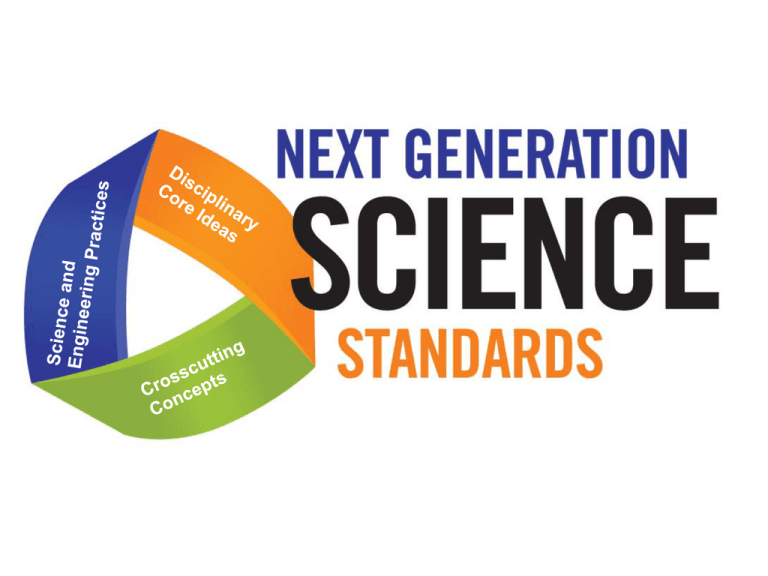
NGSS Vision • College and Career Readiness NGSS Vision • College and Career Readiness • Equity NGSS Vision • College and Career Readiness • Equity • Economic Development Overview of the Science Standards Development Process Current State of Science Standards Science documents used by states to develop standards are about 15 years old – – National Research Council’s National Science Education Standards were published in 1996 American Association for the Advancement of Science’s Benchmarks for Science Literacy were published in 1993 Call for new, internationally-benchmarked standards – – – Students in the U.S. have consistently been outperformed on international assessments such as TIMSS and PISA Too few students are entering STEM majors and careers Need for solid expectations and goals to prepare students for these fields Building on the Past; Preparing for the Future Phase I Phase II 1990s 1990s-2009 7/2010 – 12/2012 1/2010 - 7/2011 A Framework for K-12 Science Education: Practices, Crosscutting Concepts, and Core Ideas NSTA Reader’s Guide to A Framework for K–12 Science Education: Practices, Crosscutting Concepts, and Core Ideas http://www.nsta.org/store/product_detail.aspx?id=10.2505/9781936959778 Principles of the Framework K–12 Science Education Should Reflect the Real World Interconnections in Science. “The framework is designed to help realize a vision for education in the sciences and engineering in which students, over multiple years of school, actively engage in scientific and engineering practices and apply crosscutting concepts to deepen their understanding of the core ideas in these fields.” Principles of the Framework • Children are born investigators • Understanding builds over time • Science and Engineering require both knowledge and practice • Connecting to students’ interests and experiences is essential • Focusing on core ideas and practices • Promoting equity Principles of the Framework The vision represented in the Framework is new in that students must be engaged at the nexus of the three dimensions: 1. Science and Engineering Practices 2. Crosscutting Concepts 3. Disciplinary Core Ideas Principles of the Framework Science Concepts Build Coherently Across K–12 The focus on a few Disciplinary Core Ideas is a key aspect to a coherent science education. The Framework identified a basic set of core ideas that are meant to be understood by the time a student completes high school. Process for Development of Next Generation Science Standards States and other key stakeholders are engaged in the development and review of the new college and career ready science standards –State Led Process –Writing Teams –Critical Stakeholder Team –Achieve is managing the development process NRC Study Committee members to check the fidelity of standards based on framework NGSS Writing Team Members NGSS Writing Team –Will write the standards based on the NRC’s Framework for K-12 Science Education –41 members with expertise in teaching at all grade levels, working with students with disabilities, English language acquisition, state level standards/assessment, workforce development, engineering, technology, and life, earth and physical science –Includes prominent scientists and academics that have working knowledge of science standards –Selected based on recommendations from various groups including NSTA and the Council of State Science Supervisors –Led by the K-12 and postsecondary education community Lead State Partners Key Features of Lead Partner States • As a whole group, Lead Partner States have the following characteristics – Broad Geographic Representation – Account for 58% of the nation’s public school students – A bipartisan collection of states based on current governor – Are in one of the assessment consortia – Slightly more than half have grade-by-grade standards through grade eight – Most require three years of science for high school graduation Conceptual Shifts in the NGSS 1. K-12 Science Education Should Reflect the Interconnected Nature of Science as it is Practiced and Experienced in the Real World. 2. The Next Generation Science Standards are student performance expectations – NOT curriculum. 3. The science concepts build coherently from K-12. 4. The NGSS Focus on Deeper Understanding of Content as well as Application of Content. 5. Science and Engineering Standards and Practices are Integrated in the NGSS from K–12. 6. The NGSS and Common Core State Standards - English Language Arts and Mathematics are Aligned. Conceptual Shifts in the NGSS And… There is less content… Students should not just KNOW about science…they need to be able to DO science! Students need time to delve deeper… NGSS Architecture • The NGSS are written as Performance Expectations • NGSS will require contextual application of the three dimensions by students. of… Link between NGSS and CCSS… Practices… MATH M1. Make sense of problems & persevere in solving them M6. Attend to precision S2. Develop S1. Ask questions & SCIENCE define problems and use models S5. Use mathematics & S3. Plan & carry out investigations computational thinking M4. Model with mathematics S4. Analyze & interpret M7. Look for & make use E2. Build strong content data of structure knowledge M8. Look for & express E4. Comprehend as well as critique regularity in repeated E5. Value evidence reasoning M2. Reason abstractly & quantitatively M3. Construct viable argument & critique reasoning of others S7. Engage in argument from evidence S6. Construct explanations & design solutions S8. Obtain, evaluate & communicate information E6. Use technology & digital media strategically & capably M5. Use appropriate tools strategically E1.Demonstrate independence E3. Respond to the varying demands of audience, talk, purpose, & discipline ELA E7. Come to understand other perspectives & cultures Source: Working Draft v2, 12-06-11 by Tina Cheuk, ell.stanford.edu Current State Science Standard Sample Inquiry Standards a. b. c. d. e. f. g. Students will explore the importance of curiosity, honesty, openness, and skepticism in science and will exhibit these traits in their own efforts to understand how the world works. Students will use standard safety practices for all classroom laboratory and field investigations. Students will have the computation and estimation skills necessary for analyzing data and following scientific explanations. Students will use tools and instruments for observing, measuring, and manipulating equipment and materials in scientific activities utilizing safe laboratory procedures. Students will use the ideas of system, model, change, and scale in exploring scientific and technological matters. Students will communicate scientific ideas and activities clearly. Students will question scientific claims and arguments effectively. Content Standards a. b. c. d. e. f. g. Distinguish between atoms and molecules. Describe the difference between pure substances (elements and compounds) and mixtures. Describe the movement of particles in solids, liquids, gases, and plasmas states. Distinguish between physical and chemical properties of matter as physical (i.e., density, melting point, boiling point) or chemical (i.e., reactivity, combustibility). Distinguish between changes in matter as physical (i.e., physical change) or chemical (development of a gas, formation of precipitate, and change in color). Recognize that there are more than 100 elements and some have similar properties as shown on the Periodic Table of Elements. Identify and demonstrate the Law of Conservation of Matter. Standards Comparison: Illinois Science Standards STATE GOAL 12: Understand the fundamental concepts, principles and interconnections of the life, physical and earth/space sciences. Why This Goal Is Important: This goal is comprised of key concepts and principles in the life, physical and earth/space sciences that have considerable explanatory and predictive power for scientists and non-scientists alike. These ideas have been thoroughly studied and have stood the test of time. Knowing and being able to apply these concepts, principles and processes help students understand what they observe in nature and through scientific experimentation. A working knowledge of these concepts and principles allows students to relate new subject matter to material previously learned and to create deeper and more meaningful levels of understanding. A. Know and apply concepts that explain how living things function, adapt and change. EARLY ELEMENTARY LATE ELEMENTARY MIDDLE/JUNIOR HIGH SCHOOL EARLY HIGH SCHOOL LATE HIGH SCHOOL 12.A.1a Identify and describe the component parts of living things (e.g., birds have feathers; people have bones, blood, hair, skin) and their major functions. 12.A.2a Describe simple life cycles of plants and animals and the similarities and differences in their offspring. 12.A.3a Explain how cells function as “building blocks” of organisms and describe the requirements for cells to live. 12.A.4a Explain how genetic combinations produce visible effects and variations among physical features and cellular functions of organisms. 12.A.1b Categorize living organisms using a variety of observable features (e.g., size, color, shape, backbone). 12.A.2b Categorize features as either inherited or learned (e.g., flower color or eye color is inherited; language is learned). 12.A.3b Compare characteristics of organisms produced from a single parent with those of organisms produced by two parents. 12.A.4b Describe the structures and organization of cells and tissues that underlie basic life functions including nutrition, respiration, cellular transport, biosynthesis and reproduction. 12.A.4c Describe processes by which organisms change over time using evidence from comparative anatomy and physiology, embryology, the fossil record, genetics and biochemistry. 12.A.5a Explain changes within cells and organisms in response to stimuli and changing environmental conditions (e.g., homeostasis, dormancy). 12.A.5b Analyze the transmission of genetic traits, diseases and defects. 12.A.3c Compare and contrast how different forms and structures reflect different functions (e.g., similarities and differences among animals that fly, walk or swim; structures of plant cells and animal cells). Standards Comparison: Structure and Properties of Matter NGSS Middle School Sample a. Develop molecular-level models of a variety of substances, comparing those with simple molecules to those with extended structures. b. Design a solution that solves a practical problem by using characteristic chemical and physical properties of pure substances.* c. Develop a molecular level model that depicts and predicts why either temperature change and/or change of state can occur when adding or removing thermal energy from a pure substance. d. Develop molecular models of reactants and products to support the explanation that atoms, and therefore mass, are conserved in a chemical reaction. e. Analyze and interpret the properties of products and reactants to determine if a chemical reaction has occurred. f. Gather and communicate information that people's needs and desires for new materials drive chemistry forward, and that synthetic materials come from natural resources and impact society.* g. Design, construct, and test a device that either releases or absorbs thermal energy by chemical processes.* NGSS Documentation Appendices have been added to support the NGSS and in response to feedback Appendix A – Conceptual Shifts Appendix B – Responses to May Public Feedback Appendix C – College and Career Readiness Appendix D – All Standards, All Students Appendix E – Disciplinary Core Idea Progressions in the NGSS Appendix F – Science and Engineering Practices in the NGSS Appendix G – Crosscutting Concepts in the NGSS Appendix H – Nature of Science Appendix I – Engineering Design, Technology, and the Applications of Science in the NGSS Appendix J – Model Course Mapping in Middle and High School Appendix K – Connections to Common Core State Standards in Mathematics DCI Progressions Nature of Science Connections to CCSS Mathematics Model Course Mapping 1. Conceptual Progressions Model (6-8 and 9-12) — the 6-8 and 9-12 grade band PEs are organized so that student understanding of concepts is built progressively throughout the course sequence. This model maps PEs into courses based on what concepts are needed for support without focusing on keeping disciplines separate. 2. Science Domains Model (6-8 and 9-12) — the 6-8 and 9-12 grade band PEs are organized into content-specific courses that match the three science domains of the Framework: Physical Science, Life Science, and Earth Science. Since the Engineering domain is integrated into the other three in the NGSS, it was not separated out. 3. Modified Science Domains Model (9-12) — the 9-12 grade band performance expectations are organized into content-specific courses that do not match the domains of the Framework, but rather match a common high school course sequence of biology, chemistry, and physics. Preparing for the NGSS Resources Facilities Materials/equipment PD Training Courses/Curriculum revisions 36 PE: Related previous standard Disciplinary Core Idea: Practice: Objectives Classroom Activities Crosscutting Concept: Assessments Science Assessment • Well… – These standards don’t lend themselves well to being assessed by a multiple choice exam – In your classroom, begin assessing authentically • Assess PE as written! – Simulations will likely be used in a formal exam • Check out the ones on the NAEP website • University of Colorado website has some as well Commission Calls for 'Radically Different' Tests • Panel offers a 10-year plan http://www.edweek.org/ew/articles/2013/03/13/24gordon.h 32.html?tkn=SLVFZ72EJFGmbfgpnNmEXrkVdU99gH8O2Joo&c mp=ENL-CM-NEWS2 39 Balanced Science Assessment Formative • Classroom-Level Assessment Practices Summative • End of unit / assessment to assign grade • Interim / District Benchmark Assessment • Large-scale State / National Assessment A Word About Assessments… • The National Academies of Sciences’ National Research Council has convened a group of science educators to create an assessment framework based on the Science Conceptual Framework. • It will be released soon after the NGSS is complete. • Discussions have centered around performancebased assessments and computer simulations 41 http://sites.nationalacademies.org/DBASSE/BOTA/Events/index.htm https://www7.nationalacademies.org/bota/Deeper_%20Learning_Committee_Membership_and_Bios.html NGSS / ISBE Adoption and Implementation Initiatives • IL Building Capacity for State Science Education (BCSSE) • IL NGSS Adoption Committee • • • • Council of State Science Supervisors (CSSS) BCSSE Multistate Collaboration NSTA / ISTA Lead State / Achieve Update on Illinois Adoption Plans • 3/29/13 Release of NGSS Final Version • BCSSE Team working to develop documents for ISBE and the Adoption Team • NGSS IL Adoption Team will meet 4/3/13 • Presentation to Illinois State Board of Education at June, 2013 Board Meeting 45 Update on Illinois Implementation Plans Implementation Timeline: –Still in conversation –Proposed 3 year plan –Curriculum development and planning begins next year 46 http://www.isbe.net/ngss/default.htm http://www.csss-science.org/bcsse/ Recommendations Current Action Steps: • Study and integrate 8 Scientific and Engineering Practices (SEPs) into current lessons Resources for SEPs: Framework / NSTA Webinars http://learningcenter.nsta.org/products/symposia_seminars/Ngss/webseminar.aspx • Develop Assessment Literacy primarily focused on Classroom-level, Formative Assessment Practices Effective Formative Assessment for Students and Teachers (EFAST) PD http://www.isbe.net/career/html/msp.htm http://www.edweek.org/media/formative_assessment_next_generation_heritage.pdf • Advanced understanding of Framework for K-12 Science Education http://www.nap.edu/catalog.php?record_id=13165 (free registration will allow download of PDF) Recommendations Following release of NGSS at end of March, 2013: http://www.nextgenscience.org/ • Professional Learning Team Analysis of NGSS and ancillary documents • Begin with focus on your grade level and subject • Secondary close examination of preceding grade level and next grade performance expectations • Examine Scientific and Engineering Practices that are part of the performance expectations in your grade level and subject. • What might teaching and learning look like for your classes under NGSS? • What resources are you going to need in order to teach to these standards? Contact Information NGSS: www.nextgenscience.org ISBE: http://www.isbe.net/ngss/default.htm ISTA: www.ista-il.org Carol Baker: carolkeenebaker@gmail.com Gil Downey: gdowney@isbe.net
